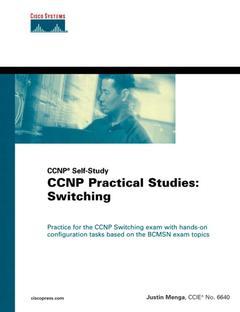Introduction. 1. Switching Connectivity. Introduction to Cisco Catalyst Switches. Scenario 1-1: Installing a Cisco Catalyst Switch onto the Network. Scenario 1-2: Configuring Network Management Access to the Switch. Scenario 1-3: Configuring Ethernet Device Connectivity. Scenario 1-4: Configuring System Time. Scenario 1-5: Monitoring and Troubleshooting Device Connectivity. 2. VLAN Operations. Introduction. Scenario 2-1: Understanding Transparent Bridging. Scenario 2-2: Configuring VLAN Trunking Protocol (VTP). Scenario 2-3: Configuring VLANs. Scenario 2-4: Configuring the Management VLAN. Scenario 2-5: Configuring Extended-Range VLANs. Summary. 3. Trunking and Bandwidth Aggregation. Introduction. Scenario 3-1: Configuring VLAN Trunking Protocol. Scenario 3-2: Configuring Trunking between Switches. Scenario 3-3: VTP Pruning. Scenario 3-4: Configuring EtherChannel. Summary. 4. Spanning Tree. Introduction. Scenario 4-1: Configuring the Root Bridge. Scenario Prerequisites. Scenario 4-2: Configuring STP Load Sharing. Scenario Prerequisites. Scenario 4-3: Configuring Root Guard. Scenario 4-4: Configuring Spanning Tree PortFast. Scenario 4-5: Configuring PortFast BPDU Guard. Scenario 4-6: Configuring PortFast BPDU Filter. Scenario 4-7: Configuring UplinkFast. Scenario 4-8: Configuring BackboneFast. Scenario 4-9: Improving Convergence and Load Sharing by Using a Multilayer Topology. Scenario 4-10: Troubleshooting Spanning Tree. Summary. 5. Inter-VLAN Routing. Inter-VLAN Routing Architectures. Multilayer LAN Design. Scenario 5-1: Configuring Basic IP Routing. Scenario 5-2: Configuring Layer 3 Switching. Scenario Prerequisites. Scenario 5-3: Implementing a Redundant Multilayer Topology Summary. 6. Layer 3 Switching. Introduction to Layer 3 Switching. Cisco Catalyst 6000/6500 Switch Architecture. Scenario 6-1: Configuring MLS on the Catalyst 6000. Scenario 6-2: Configuring CEF-based Layer 3 Switching on the Catalyst 6000/6500. Scenario 6-3: Upgrading from Hybrid Mode to Native Mode on the Catalyst 6000/6500. Scenario 6-4: Configuring CEF-Based Layer 3 Switching on the Catalyst 6000/6500. Summary. 7. Multicast Routing and Switching. Introduction. Scenario 7-1: Configuring PIM Dense Mode Multicast Routing. Scenario 7-2: Configuring PIM Sparse Mode and PIM Sparse-Dense Mode Multicast Routing. Scenario 7-3: Multicast Traffic Control on the LAN. Scenario 7-4: Configuring IGMP Snooping. Scenario 7-5: Configuring Cisco Group Management Protocol (CGMP). Summary. 8. Traffic Filtering and Security. Securing Management Access. Securing Network Access. Traffic Filtering. Scenario 8-1: Securing the Management Interface. Scenario 8-2: Enhancing Security by Using AAA. Scenario 8-3: Securing Device Access. Scenario 8-4: Securing LAN Segments. Summary. 9. Quality of Service. Introducing to QoS. Implementing Quality of Service on Cisco Switches. Scenario 9-1: Configuring QoS Features. Summary. 10. Maintenance, Monitoring, and Troubleshooting. Scenario 10-1: Using IP and LAN Connectivity Tools. Scenario 10-2: Troubleshooting Workstation Startup Problems. Scenario 10-3: Troubleshooting the errDisable Status. Scenario 10-4: Password Recovery. Scenario 10-5: File Management on Cisco Catalyst Switches. Scenario 10-6: Capturing Traffic Using SPAN, RSPAN, and VACLs. Summary. 11. Comprehensive Switching Self-Study Lab. Lab Hardware Requirements. Part I: Configuring a Layer 2 Switching Infrastructure. Part II: Multilayer Configuration. Appendix A: Comprehensive Switching Self-Study Lab Part I Solution. Appendix B: Comprehensive Switching Self-Study Lab Part II Solution.

